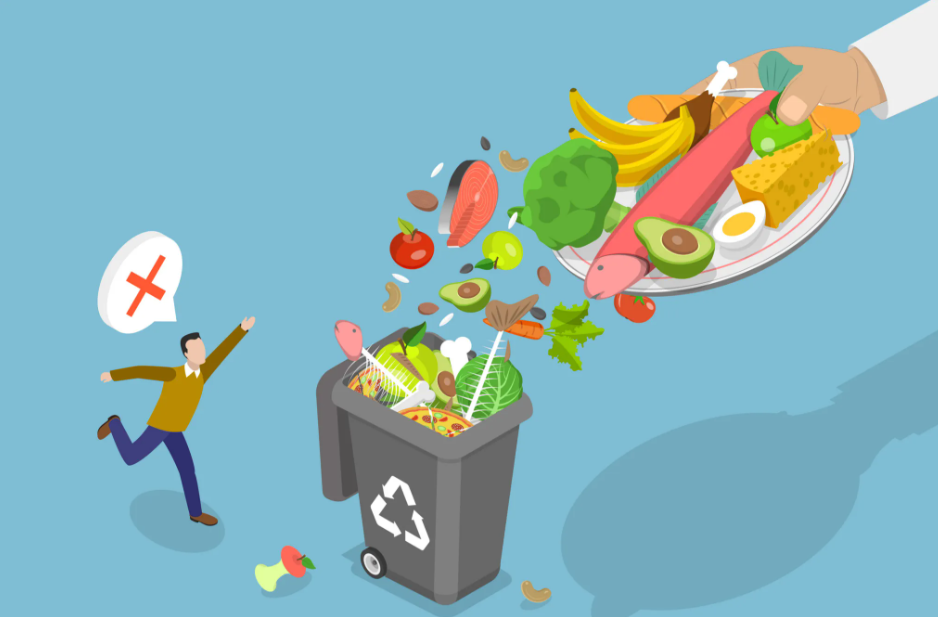Introducing Food Waste Management
Before we go through some important septs on preventing food waste let’s first have a bigger viewpoint. As everyone might be aware, food waste is an epidemic. The amount of food waste created every day threatens communities and habitats around the world. For example, in the United States, it’s estimated that 63 million tons of food is wasted every year. This wasted food represents a waste of the world’s agricultural land, significant greenhouse gas emissions, and wastes an incredible amount of water, energy, and wildlife habitat. Think about these numbers in the context of the last banquet held at your hotel, or the last breakfast buffet that was on offer. How much did that banquet or breakfast buffet contribute to these statistics? How much food was wasted?
Catering and banquets often account for the largest part of a full-service hotel’s food offerings. There are some ways of preventing food waste, and in this post will lay the foundation for you to do that. After this post, you will be able to learn about preventing food waste and its management task force, which is also responsible for implementing a culture change in the way a hotel manages food waste. You will see the importance of measuring food waste, and where to measure it. Then you will be introduced to two phases where food waste occurs in your hotel, the pre-service and post-service phases. It will take a joint effort from every department involved in banquet operations to reduce the amount of food wasted in your hotel.

For example, let’s say 100 potatoes represent all the potatoes produced in the United Kingdom. According to a UK-based study done by Wrap on how to reduce potato waste, 75% of these potatoes will be lost at various stages from farm to fork.
- 2 potatoes won’t even leave the farm
- 9 won’t make the grade of a “high quality” potato
- 3 are lost in storage
- 7 are lost during packaging
- 9 will spoil
- 20 are lost in meal preparation
- 15 are leftovers in the buffet or even in the plate
These stages of production present several opportunities to prevent food waste once ingredients arrive at your hotel. Proactively preventing food waste rather than reactively disposing of it is the key to reducing this waste. Examples of how to prevent food waste include inventory management, following “total food utilization” protocols and by revising your recipes and menus to use every single part of each ingredient. Using these techniques could save some or all of those 20 potatoes lost during meal preparation.
On average, one-third of the food produced globally is wasted. And when food is wasted, the energy, water, and wildlife habitats that were converted to produce food are wasted as well. But waste can be reduced. It required being proactive and creating a prevention-minded culture to stop food from ever becoming waste. Think about previous banquets you’ve been a part of, and consider three ways food was wasted. Can you think of any ways to have prevented this food from going to waste? Let’s go through some tips and techniques to help us identify ways to reduce food waste every day in our roles.
Building Your Food Waste Task Force
Today, the world is facing many challenges of global proportions. Unlike natural disasters that are difficult to predict or prevent, food waste is a problem that can be prevented. Like the teams of brave men and women who respond to and fight natural disasters, there are people at your hotel who are on the frontlines of the fight against food waste (if you are working in a 5-star international brand hotel). These people make up the food waste management task force, which might be called by another name in your hotel, such as the green team or environmental team.
Ask your supervisor or manager if such a task force exists in your hotel and, if not, consider advocating for one. To understand the impact a task force can have, let’s look at who makes up a task force, and the benefits of having a task force. It comprises people from different departments, but exactly who makes up a task force? A task force is created by a food waste management champion, who could be the hotel’s general manager, another member of the executive team, or another staff leader. It includes representatives from across your food operations.
By department, these are the people who often make up the task force:
- Culinary – The executive chef, sous chef, or banquet chef. They are in charge of executing the “total food utilization” concept, by developing recipes and menus that extract the most from every ingredient.
- Stewards – Who work closely with the culinary team, and play an important role in managing any underutilized food from a hotel’s operations.
- Purchasing and Receiving – They implement changes to food ordering and receiving. They ensure orders are correct, that the food received matches the order, and it is in good condition so it’s not ultimately wasted.
- Catering and Event Sales – They are involved in planning the banquet, often with the client. They inform the client of the hotel’s food waste prevention initiatives, and are also involved in preparing the banquet’s menu.
- Human Resources – They are involved in training hotel employees on food waste management. They also communicate any changes that need to be implemented, including the way food waste is measured.
- Marketing and PR – The head of marketing or marketing manager. They create documents for clients that state the hotel’s food waste management initiatives, and how the client can contribute. They also market the hotel as being food waste conscious.
- Accounting and Finance – They ensure the changes that need to be implemented to battle food waste are cost effective.
Each member of the task force fulfills their unique responsibilities, demonstrating the benefits of having a task force. The task force helps create a cultural change and their main goal is preventing food waste. They encourage food waste management as a daily duty, not additional work. They support separating and measuring food waste according to each department’s standard operating procedures. From these measurements, and supported by the food waste management champion, they help put food waste management practices in place. And it’s these practices that bring about the culture change necessary to reduce the impact of food waste from hotels.
Measuring Your Food Waste Problem
Every year, it’s estimated that 33% of all the food produced in the world is wasted. Because banquet and breakfast buffets often account for the largest amount of food used at a full service hotel, it’s essential to know how much they contribute to this 33%. Gathering food waste data allows the task force or the hotel management, to set goals and lower your hotel’s contribution to the food waste epidemic. Measurement is the first step in addressing your hotel’s food waste. To gather this data, it’s important to know what to measure, and where to measure food waste.
What to Measure?

A good place to start in lowering the amount of food waste at your hotel is knowing what to measure. For preventing food waste, the task force needs to set specific goals. To do this, they need to measure the type of food wasted and estimate how much of each item is wasted. One of the best ways to separate and measure food waste is by using various food waste tracking technologies, which capture waste at the item level. Your hotel could also use a color-coded bin system. For example, you may designate yellow bins for pre-service food waste and green bins for post-service food waste.
Once the food waste is separated, it can be weight to determine the amount of waste generated in each phase of production. Than, the hotel management or the task force need to measure the success of the goals they set. If the goals aren’t being achieved, the task force knows to experiment with additional changes to ensure less is wasted. This is a very useful data that will bring to light how food is being wasted so that plans can be implemented to prevent and minimize this.
Where to Measure Food Waste?

For preventing food waste, first, we need to measure the food waste. There are many areas in the hotel where food waste can be measured. Pre-service food waste can be produced in storage areas or kitchens if ingredients or prepared foods go unused or spoiled. Trim that’s created when preparing food becomes pre-service waste in the kitchen. Post-service food waste includes food left on Guests’ plates, in buffets in the area where the Guests ate, or in the ware washing area.
Your hotel does contribute to the food waste epidemic. But knowing exactly what, how much, and where food is wasted in your hotel is very important. As discussed above, this data allows the task force to set goals and put practices in place to minimize the food waste your hotel creates. If you are part of food management at your hotel, do your part, and keep a record of what and how much goes to waste within your daily duties; which could include during banquet preparation, and after Guests have had their fill.
Preventing Food Waste
6 Steps to Prevent Pre-Service Food Waste
In the pre-service phase, the banquet is planned, and food is ordered, stored, and prepared. There are 6 stages in the pre-service phase for preventing food waste or at least where food waste can be minimized.
- Catering Sales – The catering sales manager is a key player in preventing food waste. Encourage clients to be a partner in preventing food waste by ensuring they understand it’s causes and consequences. Use a one-pager developed by the marketing and PR department that details the harm of food waste and the hotel’s food waste initiatives. Reinforce the importance of receiving an accurate Guest count to ensure food isn’t over-prepared. Talk to your client about food rescue options for any leftovers.
- Menu Development – The chef, working with catering sales, is responsible for this stage for preventing food waste. Consider developing a special sustainability-driven menu, with an emphasis on plated entrees. Design a menu that minimizes the number of ingredients used and maximizes the amount of food made from one ingredient. Incorporate edible garnishes and bite-sized desserts. Use menu engineering and design techniques to promote plated meals.
- Sourcing and Purchasing – The purchasing director or manager is responsible in this stage. Produce that is deemed imperfect or misshapen is often discarded before even leaving the farm, but major grocers and distributors are exploring this phenomenon. So now these ugly fruits and vegetables are being used, and often sold at discounted prices. After all, it doesn’t matter what it looks like when it’s been prepared as part of a beautiful dish.
- Storing Delivered Food – The chief steward, or purchasing director or manager is responsible for this stage. The conditions in food storage areas need to be maintained at all times. They must be cleaned, well-lit, pest-free, and at the correct temperatures. Use the FIFO, or First In First Out, system. This ensures food isn’t spoiled as food that goes into storage first in is used first.
- Storing Prepared Food – The chef is responsible for this stage as well as for preventing food waste. Chefs need to follow food safety guidelines when storing prepared food to preserve quality and yield and minimize spoilage. Labeling prepared food with use-by dates also helps prevent spoilage.
- Food Preparation – Chefs are also responsible for this stage. Use the correct, high-quality equipment. Use measuring tools to ensure you don’t use too much of an ingredient, and use as much of each ingredient as possible. Don’t prepare more food than necessary, and ensure portion sizes are controlled for plated meals. Make sure bins have see-through plastic liners to make it easier to separate and measure the amount of food that’s wasted each day from preparation activities.
The pre-service phase contributes a staggering amount to preventing food waste. By minimizing the amount of food your hotel needs, you contribute to ensuring all food that is produced is used and doesn’t go to waste. Those were the 6 steps in the pre-service phase in which food waste can be proactively prevented.
Preventing Post-Service Food Waste

Think about the amount of food that is left over after a banquet. Think about the number of hungry people in your city. Surely, this food could feed them. And if it can’t feed them, there must be a way to manage the waste in environmentally friendly ways. When the banquet is done, food enters the post-service phase. This is one of the key points where stewards come in to ensure that food is donated or disposed of properly. It’s in this phase that your hotel can either donate or dispose of food waste with the goal of avoiding landfills. The best way to manage leftover food in the post-service phase is to donate it. Globally, approximately 795 million people are undernourished. Donating food can address food insecurity and malnutrition and it is completely legal. There is very little legal or reputational risk for donating food as long as local food safety regulations and best practices are followed when preparing, storing, and transporting food for donation.
Disposal of Food Waste
If your hotel can’t donate leftover food, it may have to dispose of it. Your hotel will have to dispose of the food waste rather than donate it for different reasons, like if it’s scraps from a Guest’s plate, inedible parts, or high-risk expired food. Food should be donated when possible and when it cannot be donated it should be diverted away from landfill.
The hotel’s waste hauler and director of property operations will work together to implement the most appropriate, economical, and feasible disposal method for your hotel. They will consider criteria such as the location of the nearest compost facility or the cost of installing and maintaining an onsite operation. These two parties will work together to set up a food waste disposal system.
Featured image from Green.


